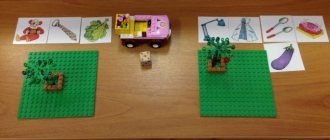Programming Ev3 in python
https://www.clubengineer.org/cheat-sheets/python-for-ev3dev/
Python documentation Ev3Dev
Ev3 Assembly Instructions
School tour of the Robotics Olympiad
Task 1. Write a program that counts people passing by the spy robot within 10 seconds. The answer is to produce sound number 1 the same number of times as people have passed.
Task 2. Write a program in which the motor power depends on the angle of inclination of the sensor up or down (for airplane and helicopter models).
Task 3. Organize listening in a loop to all the sounds from the WeDo 2.0 library and displaying the sound number on the screen. Do the same for the backgrounds.
Task 4. Display a random number and the background corresponding to this number. Do the same for backgrounds 11 to 20.
Task 5. Write a program to solve the example:
1) 5+3*5
2) 21/7+2
3) (45-5)/8
Display the answer on the screen.
Task 6. Organize the display of odd numbers from 1 to 10.
Task 7. Write a program to count down from 64 in steps of 8; when 0 is reached, the word “stop” should appear and the program should stop.
Task 8. Write a program to display a random number on the screen. If the random number is 1, the motor turns on for 1 second. If it is 3, sound 1 is played 3 times, if the number is 7, background number 7 is displayed on the screen. Otherwise, nothing happens.
Task 9. Write a program that, when you tilt the tilt sensor to the right, lights up a red indicator and displays the word “Stop” on background number 27, and when tilted to the left, it lights up green and displays the word “Walk” on background number 5.
Task 10. The program must solve example 36:12, play the sound with the received number and turn on the motor for the given number of seconds.
Task 11. Each time the distance sensor is triggered, the program should turn on the motor at power 6 counterclockwise for half a second and display a random background with its number on the screen.
Task 12. Write a program that, after starting, played sound 1 4 times, then after 2 seconds displayed the message “Waiting for an up tilt” and, after waiting for the sensor to tilt up, turned on the motor and played sound 9 until the stop button is pressed.
Answers.
Exercise 1.
Lesson summary on the topic: “LEGO WeDo Robot – Algorithm Executor”
09.08.2016, 12:51Home » Articles » Lego constructors » Page 2 » Lego Vedo lesson notes
Kriventsov L.A.,
computer science and ICT teacher
MBOU "Secondary School No. 4" in Asino, Tomsk Region
Lesson from the computer science and ICT course, section – “Algorithms”. During the lesson, using a construction set, students build a Lego model, connect it to a LEGO switch and control it using a computer program built according to a specific algorithm.
Goals
:
- introduction to robotics using the LEGOWeDo PervoRobot constructor ( LEGO Education WeDo Construction Set
); - systematization of knowledge on the topic “Algorithms” (using the example of the work of LEGOWeDo Robots);
- mastering the concepts of algorithm, executor, properties of an algorithm, to give an idea of composing the simplest algorithms in the LEGO Education environment.
During the lesson, students must demonstrate the following results in the form of universal learning actions:
- Regulatory:
- systematize and generalize knowledge on the topic “Algorithms” for the successful implementation of the operating algorithm of the assembled robot;
- Learn to program robots using the LEGO EducationWeDo program.
- Cognitive:
- Studying robotics, creating your own robot, learning to program using LEGO WeDo;
- experimental study, assessment (measurement) of the influence of individual factors.
- Communication:
develop communication skills when working in a group or team. - Personal:
development of memory and thinking, the opportunity to study robotics in senior years.
Lesson type:
combined
Lesson type:
practical work
Equipment
: multimedia projector, LEGO WeDo 9580 construction set (5 pcs.), the set of which includes 158 elements, including a USB LEGO switch, motor, tilt sensor and distance sensor.
Lesson plan:
- Organizational moment (2 min)
- Repetition of theoretical material from the previous lesson (10 min)
- Practical work: developing an algorithm for a robot (23 min)
- Summing up the lesson. Reflection (3 min)
- Homework Information Stage (2 min)
During the classes:
- Organizing time.
Teacher
: Good afternoon guys! In the last lesson you were introduced to an important topic in computer science. Which? Today we will continue our study of the topic “Algorithms” and get acquainted with one of the most common algorithm performers - a real robot.
II. Repetition of theoretical material from the previous lesson.
Teacher
: Each of us uses various algorithms every day: instructions, rules, recipes, etc. We usually do this without thinking. For example, you know well how to brew tea. But let's say we need to teach this to a younger brother or sister. This means that we will have to clearly indicate the actions and the order in which they should be performed.
What will these actions be and what is their order?
Students make up a rule for brewing tea.
- To boil water.
- Pour boiling water over the teapot.
- Pour the tea leaves into the teapot.
- Pour boiling water over it.
- Close the lid.
- Cover with a towel.
Now let's answer the following questions:
- What is an algorithm?
- What are algorithms for?
- What properties do algorithms have?
- Who is the performer?
Students answer the proposed questions, and the teacher demonstrates the correct answers on slides.
III. Practical work: developing an algorithm for a robot
Now let's turn to our robots (in this lesson, these are cranes, created without instructions), which we assembled in the last lesson.
Let's try to create an algorithm in a special program that they will execute using the following commands:
Exercise 1:
write an algorithm with which the crane will lower the sling onto the table (or floor) without touching it, and then lift it back up.
First, let's determine what commands we need, in which direction the motor should turn, the period of time the motor will operate and the sequence of command execution.
Correct option:
Note:
The operating time of the motor in each individual case will be different if the height of the crane is not made the same in all groups.
Task 2:
change the created linear algorithm to cyclic (it is possible to set the number of repetitions of the cycle).
Correct option:
Task 3:
change the algorithm at your discretion and explain what exactly it will do, for example:
Description of actions: lower and raise the sling 3 times to the same height, then lower the sling with a pause of 50, which is enough to secure something on the sling and then lift it up with the load.
IV. Summing up the lesson. Reflection.
So, guys, let's summarize our work.
- What types of algorithms have we considered in practice today?
- What other function can be implemented in the robot crane operating algorithm?
V. Homework information stage.
Write down your homework: think about and sketch out an example of your own performing robot and write an algorithm for its operation in natural language.
The assignment will definitely be appreciated!
Thank you for the lesson! Goodbye, guys.
Source: doc4web.ru
To the Star Wars project
EV3. Walker. Instructions
WeDo 2.0. Step-by-step instructions for assembling an echolocator
Echolocators
WeDo 2.0. Star Wars. AT-ST walker
Abstract of an open lesson on robotics "Helping friends"
Open lesson summary
on robotics for parents
"Help the Planet Robotav"
Head: Shishkina Yulia Aleksandrovna
Target:
development of technical creativity of children based on the Lego Education WeDo, Lego Education WeDo 2.0 constructor
Tasks:
Educational:
- Strengthen knowledge, skills and abilities when working with the Lego Education WeDo, Lego Education WeDo 2.0 constructor
- To develop the ability to design and program animal models, the robot Milo
- Develop the ability to analyze your own activities.
Educational:
- To develop children's cognitive interest, attention, spatial and visually effective thinking, speech, fine motor skills, and engineering programming skills.
- Develop productive (constructive) activities: ensure that children master basic techniques for assembling and moving robotic devices.
Educational:
- To cultivate emotional responsiveness, mutual assistance, communication skills (the ability to work in a group and in pairs), independence.
Materials and equipment:
Lego Education WeDo, Lego Education WeDo2.0, PC, tablets, interactive whiteboard, presentation, music
Preliminary work:
looking at pictures of animals, robots, conversations, watching the cartoon “The Secret of the Third Planet”, game situations.
GCD move:
- Organizing time
Educator:
All the children gathered in a circle,
I am your friend and you are my friend.
Let's hold hands tightly,
And let's smile at each other
(They smile at each other.)
Educator:
Attention, an SOS signal has been received from the planet Robotav. I turn on the recording.
- “Attention, attention, I —
Robot from the planet Robotav
, from
the planet Robotav.
A terrible disaster has happened on my planet. A few days ago there was
a strong hurricane
.
A terrible storm with strong wind swept away everything in its path. And all the inhabitants of my planet were carried away far, far away. I was left alone. Guys, help me, please."
Educator:
Guys, what happened? -Who do you think inhabited the planet? (Children's answers)
Educator:
Guys, can we help the robot?
Children: Yes.
Educator:
How can we help? (children's answers). We can make models of robotic animals from construction kits. Is it true?
Who can tell me what we should do to make our animal robot models come to life? (Children's answers)
Well done! Of course, write a program.
Well done! Of course, write a program.
After completing the models, we will be happy to see how they move.
Well, are you ready? (Students' answers)
Come in, take your seats.
Well, decide for yourself which robotic animals you will collect, negotiate together.
2. Main part
Before we start work, let's do finger exercises
“We are cool guys
We'll build everything, we'll fix everything,
We love to play with LEGO
Our motto is “Don’t get tired!”
Educator:
Let's start doing the work, open our program “LEGO LEAD on laptops. Let's go to the model block. We choose an animal, take construction kits and start assembling!!!
If anyone needs my help, raise your hand and I will come.
Calm music plays while the children work.
Independent work of children.
Physical education minute
We've done a good job, and now let's warm up a little. Let's get up and do some exercises together with the animations
.
(Appendix 4. Demonstration of presentation with physical education)
Educator:
So are our robots ready? Now let's check if we did everything correctly, and if so, then the models we made will come to life.
I'm sure everyone did a great job.
(Children's answers)
Educator:
Congratulations to all of you! All our robots have come to life, which means there are no errors!
(Children's answers)
Educator:
We helped a robot from the planet Robotav? Now do you think he won’t be bored on his planet?
3.Reflection
-Were there any difficulties in creating the inhabitants of the planet Robotav?
-What parts were used to create the models?
-What other models can you come up with and create?
-What do you think is easier to build - according to a plan or to invent it yourself?
Cleaning the workplace
You know that after work you need to turn off the computers, clean your workplace, and tidy up your study room.
Students clean their workspaces.
Present children with Legomaker diplomas.
Educator:
You guys are all great, I want to thank you and present you with a real document stating that you are now real LEGOMASTERS!!!
WeDo 2.0
Lesson 1. Gears. Direction of rotation.
Homework 1. Virtual gears.
Lesson 2. Transfers. Change speed.
Homework 2.
Lesson 3. Belt drive.
Homework 3.
Lesson 4. Belt drive. Direction of rotation.
Homework 4.
Lesson 5. Changing the direction of rotation at an angle.
Homework 5.
Lesson 6. Traction force.
Homework 6.
Lesson 7.
Homework 7.
Lesson 8.
Homework 8.
Lesson 9.
Homework 9.
Lesson 10.
Homework 10.
Lesson 11.
Homework 11.
Lesson 12.
Homework 12.
Task 13.








